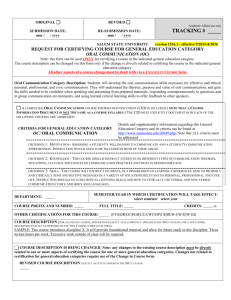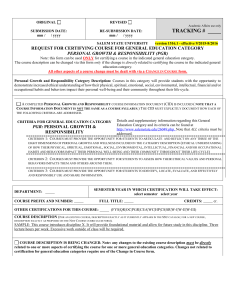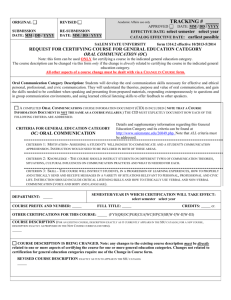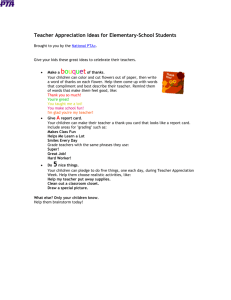Creative Expression & Appreciation
advertisement
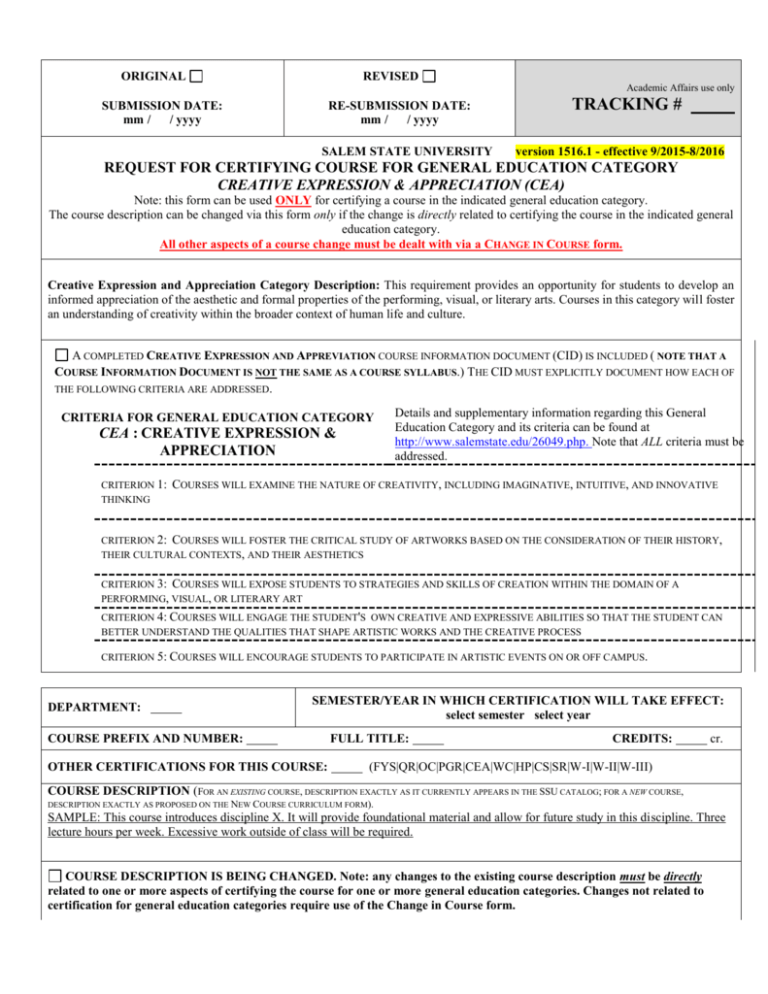
ORIGINAL
REVISED
Academic Affairs use only
SUBMISSION DATE:
mm /
/ yyyy
RE-SUBMISSION DATE:
mm /
/ yyyy
SALEM STATE UNIVERSITY
TRACKING #
version 1516.1 - effective 9/2015-8/2016
REQUEST FOR CERTIFYING COURSE FOR GENERAL EDUCATION CATEGORY
CREATIVE EXPRESSION & APPRECIATION (CEA)
Note: this form can be used ONLY for certifying a course in the indicated general education category.
The course description can be changed via this form only if the change is directly related to certifying the course in the indicated general
education category.
All other aspects of a course change must be dealt with via a CHANGE IN COURSE form.
Creative Expression and Appreciation Category Description: This requirement provides an opportunity for students to develop an
informed appreciation of the aesthetic and formal properties of the performing, visual, or literary arts. Courses in this category will foster
an understanding of creativity within the broader context of human life and culture.
A COMPLETED CREATIVE EXPRESSION AND APPREVIATION COURSE INFORMATION DOCUMENT (CID) IS INCLUDED ( NOTE THAT A
COURSE INFORMATION DOCUMENT IS NOT THE SAME AS A COURSE SYLLABUS.) THE CID MUST EXPLICITLY DOCUMENT HOW EACH OF
THE FOLLOWING CRITERIA ARE ADDRESSED.
CRITERIA FOR GENERAL EDUCATION CATEGORY
CEA : CREATIVE EXPRESSION &
APPRECIATION
CRITERION 1:
THINKING
Details and supplementary information regarding this General
Education Category and its criteria can be found at
http://www.salemstate.edu/26049.php. Note that ALL criteria must be
addressed.
COURSES WILL EXAMINE THE NATURE OF CREATIVITY, INCLUDING IMAGINATIVE, INTUITIVE, AND INNOVATIVE
CRITERION 2: COURSES WILL FOSTER THE CRITICAL STUDY OF ARTWORKS BASED ON THE CONSIDERATION OF THEIR HISTORY,
THEIR CULTURAL CONTEXTS, AND THEIR AESTHETICS
CRITERION 3: COURSES WILL EXPOSE STUDENTS TO STRATEGIES AND SKILLS OF CREATION WITHIN THE DOMAIN OF A
PERFORMING, VISUAL, OR LITERARY ART
CRITERION 4: COURSES WILL ENGAGE THE STUDENT'S OWN CREATIVE AND EXPRESSIVE ABILITIES SO THAT THE STUDENT CAN
BETTER UNDERSTAND THE QUALITIES THAT SHAPE ARTISTIC WORKS AND THE CREATIVE PROCESS
CRITERION 5: COURSES WILL ENCOURAGE STUDENTS TO PARTICIPATE IN ARTISTIC EVENTS ON OR OFF CAMPUS.
DEPARTMENT:
SEMESTER/YEAR IN WHICH CERTIFICATION WILL TAKE EFFECT:
select semester select year
COURSE PREFIX AND NUMBER:
OTHER CERTIFICATIONS FOR THIS COURSE:
FULL TITLE:
CREDITS:
cr.
(FYS|QR|OC|PGR|CEA|WC|HP|CS|SR|W-I|W-II|W-III)
COURSE DESCRIPTION (FOR AN EXISTING COURSE, DESCRIPTION EXACTLY AS IT CURRENTLY APPEARS IN THE SSU CATALOG; FOR A NEW COURSE,
DESCRIPTION EXACTLY AS PROPOSED ON THE NEW COURSE CURRICULUM FORM).
SAMPLE: This course introduces discipline X. It will provide foundational material and allow for future study in this discipline. Three
lecture hours per week. Excessive work outside of class will be required.
COURSE DESCRIPTION IS BEING CHANGED. Note: any changes to the existing course description must be directly
related to one or more aspects of certifying the course for one or more general education categories. Changes not related to
certification for general education categories require use of the Change in Course form.
REVISED COURSE DESCRIPTION EXACTLY AS IT IS TO APPEAR IN THE SSU CATALOG
NOTES (NOT FOR INCLUSION IN CATALOG):
SUBMITTED BY:
Department
(name of department chairperson)
(name of sponsor / contact person only if other than department chairperson )
department name Department
department website URL
Creative Expression and Appreciation Course Information Document
PREFIX nnn Course Title
n cr. CEA
Catalog description:
Course description. Focus on the course goals in developing the description; do not incorporate implementation details unless
they are directly related to course goals. [n lecture hours [and m hours of scheduled laboratory per week] [plus work outside of class].]
Prerequisites: list all prerequisites (delete this line if there are no prerequisites)
Course Narrative:
Provide a reasonable (two to four paragraph) narrative that goes beyond the course description in articulating the pedagogical and
disciplinary mission and scope of the course. Think of this narrative as a means of connecting the dots between the course description
and course goals and outcomes.
Your narrative must include a separate description of how the criteria for certifying the course for the Creative Expression and
Appreciation general education category are addressed.
Course Goals:
(The wording of course goals may be phrased to meet disciplinary standards.)
This course will {introduce | explain | examine | …}:
G1:
G2:
G3:
general goal (not necessarily directly measureable);
general goal;
general goal; (insert additional goals as needed; try for no more than 3-5 goals)
Course Outcomes (Objectives):
(The wording of course outcomes may be phrased to meet disciplinary standards but outcomes must be assessable / measurable.)
Upon successful completion of the course, a student will be able to {demonstrate | explain | demonstrate | identify | …}:
O1:
O2:
O3:
specific (measurable!) objective (stated as something that the student did during the course);
specific (measurable!) objective;
specific (measurable!) objective; (insert additional objectives as needed; try for no more than 4-8 objectives)
Topics:
(Note: for special topics courses, provide appropriate separate topic outlines for two different special topics.)
topic one
sub-topic
sub-sub-topic
topic two
sub-topic
sub-sub-topic
Student Experiences: Describe the various type(s) of student experiences that will be used to assess student learning vis-à-vis stated
course objectives, e.g. presentations, tests, lab reports, writing projects, discussions, performances, etc. For each type, briefly describe
what the activity entails and provide an example or two of a typical assignment. Note that these examples are not meant to be prescriptive.
Student Experiences by Course Outcome (Objective) matrix:
(Eliminate or add columns and/or rows as necessary; each row represents a student experience (similar experiences should be grouped
if appropriate - this is NOT meant to be a list of every student experience); each column relates a student experience type to the relevant
course outcomes (objectives). Insert a check mark () in any cell where a given course objective is assessed via a specific student
experience.)
student outcome / experience
(e.g. presentations, tests, lab reports, writing projects,
discussions, performances, etc.)
O1
O2
O3
O4
O5
O6
CREATIVE EXPRESSION AND APPRECIATION CRITERIA AND WHERE / HOW THEY ARE ADDRESSED IN THIS COURSE
CRITERIA FOR GENERAL EDUCATION
CATEGORY CEA: CREATIVE EXPRESSION
AND APPRECIATION
CREATIVE EXPRESSION AND
APPRECIATION CRITERIA
CRITERION 1: COURSES WILL EXAMINE THE
NATURE OF CREATIVITY, INCLUDING
IMAGINATIVE, INTUITIVE, AND INNOVATIVE
THINKING
CRITERION 2: COURSES WILL FOSTER THE
CRITICAL STUDY OF ARTWORKS BASED ON
THE CONSIDERATION OF THEIR HISTORY,
THEIR CULTURAL CONTEXTS, AND THEIR
AESTHETICS
CRITERION 3: COURSES WILL EXPOSE
STUDENTS TO STRATEGIES AND SKILLS OF
CREATION WITHIN THE DOMAIN OF A
PERFORMING, VISUAL, OR LITERARY ART
CRITERION 4: COURSES WILL ENGAGE THE
STUDENT'S OWN CREATIVE AND EXPRESSIVE
ABILITIES SO THAT THE STUDENT CAN BETTER
UNDERSTAND THE QUALITIES THAT SHAPE
ARTISTIC WORKS AND THE CREATIVE PROCESS
CRITERION 5: COURSES WILL ENCOURAGE
STUDENTS TO PARTICIPATE IN ARTISTIC
EVENTS ON OR OFF CAMPUS.
DETAILS AND SUPPLEMENTARY INFORMATION REGARDING THIS GENERAL
EDUCATION CATEGORY AND ITS CRITERIA CAN BE FOUND AT
http://www.salemstate.edu/26049.php. NOTE THAT ALL CRITERIA MUST BE
ADDRESSED.
Course outcome(s) For each Creative Expression and Appreciation criterion,
(objective(s)) that
locate and identify CID elements aside from course outcomes,
address a criteria
particularly student experiences, which are directly related to
(e.g. O3, O6)
that criterion.
Sample Bibliography: (required for new courses only) (format as appropriate for your discipline; representative resources, not required
to be exhaustive)
(Note: for special topics courses, provide representative sample bibliographies for two different special topics.)
(examples)
Booch, Grady; Rumbaugh, James; Jacobson, Ivar. The Unified Modeling Language User Guide. Second Edition. AddisonWesley, 2005.
Gamma, Erich; Helm, Richard; Johnson, Ralph; Vlissides, John. Design Patterns: Elements of Reusable Object-Oriented
Software. Addison-Wesley, 1995.
Hwang, K.; Fox, G.; Dongarra, J. Distributed and Cloud Computing: From Parallel Processing to the Internet of Things.
Morgan Kaufmann, 2012.
(General Notes: anything in red must be deleted or replaced (and changed to black). Anything in red and in parentheses (like this note)
is an advisory comment and must be deleted. Note that while additional components may be inserted if appropriate, listed components
must be included. For examples, visit http://www.salemstate.edu/26049.php.)
